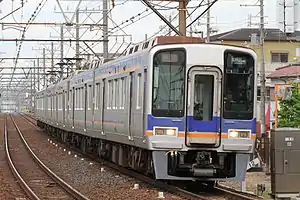Nankai 2000 series
The Nankai 2000 series (南海2000系) is an electric multiple unit (EMU) train type operated by the private railway operator Nankai Electric Railway in Japan since 1990.[1]
| Nankai 2000 series | |
|---|---|
 Nankai 2000 series train at Asakayama station | |
| In service | 1990– |
| Manufacturer | Tokyu Car Corporation |
| Constructed | 1990–1997 |
| Entered service | 1990 |
| Number built | 64 vehicles (23 sets) |
| Number in service | 64 vehicles (23 sets) |
| Formation | 2/4 cars per trainset |
| Fleet numbers | 2001–2003, 2021–2024, 2031–2046 |
| Operator(s) | Nankai Electric Railway |
| Line(s) served | Nankai Main Line Nankai Airport Line Nankai Koya Line |
| Specifications | |
| Car body construction | Stainless steel |
| Car length | 17,000 mm (55 ft 9 in) |
| Width | 2,744 mm (9 ft 0 in) |
| Height | 4,130 mm (13 ft 7 in) |
| Doors | 2 pairs per side |
| Maximum speed | 110 km/h (70 mph) (Main line, Airport line) 100 km/h (60 mph) (Koya Line) |
| Traction system | Hitachi GTO–VVVF |
| Acceleration | 3.1km/h/s |
| Electric system(s) | 1,500 V DC overhead wire |
| Current collection method | Pantograph |
| Multiple working | 2200 series 2300 series |
| Track gauge | 1,067 mm (3 ft 6 in) |
Operations
The 2000 series is used mainly on Koya Line services singly or coupled with 2200 series or 2300 series EMUs. All two-car sets along with four four-car sets are allocated to Koya Line services. The remaining six four-car sets are allocated to Nankai Main line services.
These units differ from other trains on the Nankai main line in that the cars only have only two doors per side.
Formations
As of June 2020, the fleet consists of six two-car sets (1001 to 1010), one four-car set (1051), and ten six-car sets (1031 to 1036). All the "Tc" and "Tc1" cars are at the Osaka-Namba end. The sets are formed as follows.
2-car sets
Cars were built between 1994 and 1997.
| Designation | Mc1 | Tc |
|---|---|---|
| Numbering | MoHa 2001 | KuHa 2151 |
- The "Mc1" car is fitted with two scissors-type pantographs.
4-car set
Cars were built between 1990 and 1997. The pantograph position varies by set.
| Designation | Mc1 | M2 | M1 | Mc2 |
|---|---|---|---|---|
| Numbering | MoHa 2001 | MoHa 2051 | MoHa 2101 | MoHa 2151 |
- On the first three sets manufactured in 1990, the "Mc1" car and the "M1" car are fitted with one scissors-type pantograph.
- On the six sets built between 1994 and 1997, the "Mc1" car is fitted with two single arm-type pantographs.
- Two-car sets 2031 and 2032 are a semi-permanent four-car set configured in an "Mc1-Mc2-Mc1-Mc2" formation. Pantograph position is the same on "Mc1" cars on two-car sets.
Interior
All cars feature longitudinal seating throughout in the first five batches. On the last two batches, all cars feature logitudinal seating except in the car ends where there are two rows of seats in a 2+2 configuration which face each other.
History
The trains were introduced in seven batches between 1990 and 1997. They were originally introduced for Koya line services. Over time, they were gradually moved to Nankai Main line and Airport line services.
The first four-car sets were delivered with a green stripe instead of the usual Nankai livery. All cars currently feature the standard Nankai Line livery.
Gallery
 Inside a 2000 series car (later batch)
Inside a 2000 series car (later batch) Four-car set 2003 in the original green livery
Four-car set 2003 in the original green livery Set 2022 leading a six-car service to Osaka-Namba
Set 2022 leading a six-car service to Osaka-Namba
References
- "現在の車両 - 鉄道博物館" [Current Vehicles-Railway Museum]. Nankai (in Japanese). Retrieved January 27, 2021.
External links
| Wikimedia Commons has media related to Nankai 2000 series. |
- Nankai rolling stock information (in Japanese)